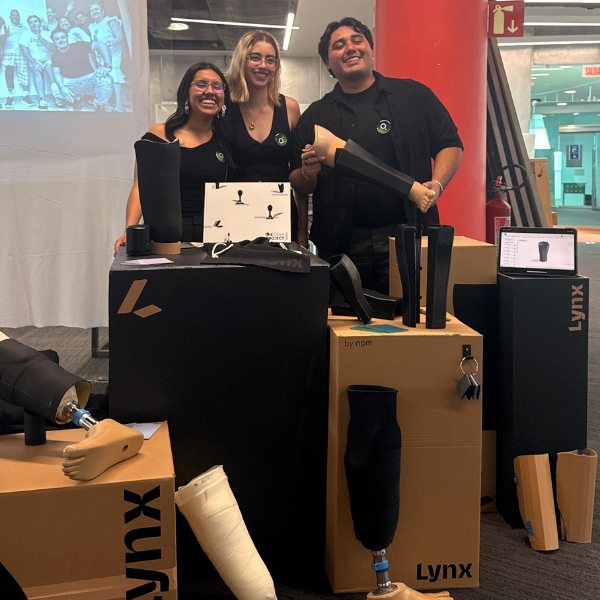What it does
Lynx is a prosthetic system for transtibial amputations. It includes a lower limb socket and a cosmetic cover, aiming to democratize access to prostheses in Mexico through an efficient, accessible, and customizable manufacturing process.
Your inspiration
The name Lynx has a dual inspiration: the lynx, an agile and adaptable animal, and the verb "link," symbolizing connection between body and technology.The inspiration came from a single moment; how long patients need to wait for a prosthesis and how few of them truly have the opportunity to access one. After extensive research, interviews, and fieldwork with professionals and users who shared their experiences, we learned how current solutions often fail in affordability, production time, and personalization. Their stories became our call to action.
How it works
Prostheses consist of several components; some, like feet, tubes, or adapters, are mass-produced, while others, such as sockets or transtibial covers, are custom-made through artisanal methods, significantly raising costs. That’s why Lynx focuses on these two components. Lynx Core is the structural heart of the system. It enables prosthetists to create sockets using low-cost materials (fiberglass tubes and bandages with an Evalastic foam coating). Using the Direct Socket technique, it adapts directly to the patient’s limb in a single session, offering comfort, durability, and precise fit. Lynx Skin is a software-guided solution for 3D printing cosmetic covers, tailored to each user's measurements. It standardizes production without losing personalization. Made from recycled PET with carbon fiber, it’s lightweight, durable, and enhances both aesthetics and confidence.
Design process
At the beginning of the project, we connected with two passionate prosthetists who were also motivated to change lives. They mentored us and introduced us to the world of prosthetics. Later, we traveled to Cuautla, Mexico, where we worked closely with them. They allowed us to validate the fabrication process of the Lynx Core using the Direct Socket machine and fiberglass bandages. We selected this material because it is a high-value technical option for socket structures; its adaptability to direct manufacturing processes and relatively low cost make it a validated solution in both laboratory and field settings. Furthermore, we had the opportunity to validate the functionality of the Lynx Core with two users, who tested the final prototype for 15 days. After that period, we received encouraging feedback from both professionals and users. For Lynx Skin we found that covers are expensive and not standardized to meet users' needs. This insight was reinforced after validation with the prosthetists, leading us to address the problem by designing a cover using parametric measurements to adapt to each user's dimensions, making them personalized. For this component, we selected recycled PET reinforced with carbon fiber, a combination that offers the necessary rigidity and durability.
How it is different
Lynx stands out for combining fast fabrication, affordability, comfort, and emotional connection. While low-cost prosthetics lack customization and high-end options are slow and unaffordable, Lynx bridges that gap through an optimized socket method and recycled materials for the cosmetic cover. Using the Direct Socket technique, prosthetists can fabricate Lynx Core in just 30 minutes, allowing users to leave with a functional prosthesis in only three hours, is 82% more affordable than market alternatives, and Lynx Skin, the customizable 3D-printed cover made from recycled PET and carbon fiber, is 77% more affordable than imported options. Lynx also promotes a sustainable, decentralized model, enabling prosthetists to fabricate both components in-clinic, reducing time, costs, and environmental impact.
Future plans
This is just the beginning. As we grow, we’ll keep prototyping, testing, and refining, always with experts and users, to ensure that Lynx becomes not just a product, but a movement toward more beautiful, bold, human-centered prosthetics. We also aim to develop our parametric design software into a robust tool that helps prosthetists create better-fitting covers with ease, and expand Lynx’s impact through alliances with prosthetic clinics across Mexico. The goal is simple: to change more lives, one at a time, with a system that is thoughtful, functional, and designed to leave no one behind and celebrate identity.
Awards
Nominated for Best Project in the design course: Form, Function, Meaning, and Value, for standing out in conceptual proposal, execution, and meaningful contribution throughout the semester.



Share this page on